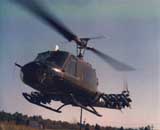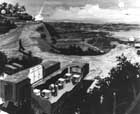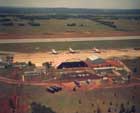1966
1966 After the laser guided bomb was successfully demonstrated during the year, it was then developed for combat use in the air war over North Vietnam. The laser guided weapon initiated by the Army saw its first combat as a "smart" bomb for the Air Force.
See article on "smart" bomb development efforts at Redstone Arsenal
1966 The new Stovepipe special supply support system was implemented. It was an innovative logistics system with operational readiness as the paramount consideration. It had been created because there was no Army HAWK logistics support system in Vietnam at the time of deployment.
1966 The first MICOM managed M22 subsystems were deployed to Vietnam for use by the 1st Cavalry Division. The M22 Armament Subsystem, the U.S. designation for the French built SS-11B (the aircraft armament subsystem modification of the SS-11), was successfully used on 9 October 66 during the campaign to pacify the Binh Dinh Province. The 2d Battalion, 20th Artillery (Aerial Rocket Artillery) of the 1st Cavalry Division fired M22 missiles which destroyed bunkers on the peninsula, resulting in the capture of 55 Viet Cong without a fight. Additional M22 deployments to Vietnam were made in 1967 and 1972.

1966 The SERGEANT was the first missile system tested for susceptibility to electronic magnetic radiation at WSMR.
January 66 AMC began requiring the submission of a quarterly "Lessons Learned" report through it to DA. The latter agency instituted the report because of indications during the Dominican Republic and Vietnam actions that personnel at all echelons had to frequently relearn lessons that the nation should have learned from World War II and Korea.
January 66 A life-size model of a Viet Cong village was built on Redstone Arsenal as part of a new training program at OMMCS for personnel headed for duty in Vietnam. In addition to the tunnels, huts, shelters, and living facilities found in a real Vietnamese community, booby traps, mines, bamboo spikes, and other war devices unique to the Viet Cong made the training more realistic.
24 January 66 IADS was redesignated PM, VULCAN/CHAPARRAL Air Defense System.
8 April 66 MICOM's mission was expanded to include operation of the Army Propulsion Technology and Management Center at RSA, which provided centralized monitoring of all Army missile and rocket propulsion research and development programs.
15 April 66 The MICOM General Counsel was redesignated Chief Counsel to comply with an AMC regulation specifying the new name.
25 April 66 After it was determined that the U.S. Navy, NASA, and Great Britain had no need for the CORPORAL, disposal action was started on about $17 million worth of major and secondary items for the obsolete system.
11 May 66 The Vice Chief of Staff of the Army (VCSA) approved Type Classification Standard "A" for the SHILLELAGH missile system.
July 66 The Army's new air defense distribution system - the AN/TSQ-51 Missile Mentor - went into operation in the Chicago area. Deployment of the system marked one of the first applications of second-generation solid state and computer technology to command and control of missile systems in the field. It also heralded the end of the Missile Master which had been in service since 1957.

12 September 66 The Redstone Arsenal Non-Commissioned Officers (NCO) Club, Building 3513, was completely destroyed by fire, a loss of $145,802.
15 September 66 The John M. Cone Laboratories, named for the general who was the WSMR commander at the time of his death in 1965, was formally dedicated. Redstone Arsenal's newly constructed metrology center was the largest of its type in DOD.

October 66 Raytheon delivered Saudi Arabia's first HAWK battery.
October to December 66 Three SERGEANT missiles were fired successfully from a sea level site at Tyndall AFB, marking the first time that a major ballistic missile was fired along an occupied coastline.
2 October 66 The MICOM Commander delegated responsibility and authority for operating RSA as an installation (except where prohibited by law or regulation) to the head of the new provisionally established Directorate of Arsenal Support Operations (DASO). Although this organization replaced AMSC, both organizational names officially remained in existence during the provisional period. In order to establish the single commander concept, the MICOM Commander assumed command of AMSC for the duration of the provisional period.
2 October 66 A Special Assistant for Equal Opportunity was added to the MICOM Headquarters staff.
28 November 66 A total of 10 missiles were launched between this date and 29 November 67 from Woomera, South Australia, as part of the SPARTA program. The last missile lofted the Australian WRESAT I satellite into orbit.
December 66 The Advanced Forward Area Air Defense Systems (AFAADS) Project Office was established in the Future Missile Systems Division of the MICOM Research and Development Directorate. Its mission was to plan and coordinate a program of advanced development leading to eventual contract definitions and engineering development of a family of AFAADS (including both guns and missiles) to complement SAM-D in the post-1975 time frame. In the last quarter of FY 1986, management responsibility for the AFAADS program was transferred to the Advanced Systems Laboratory.
20 December 66 The MICOM Staff Aviation Officer (Provisional) was established. The new element, which would function as a Special Assistant, served as the principal advisor to the MICOM Commander and exercised staff supervision and coordination over MICOM's aviation activities.

Excellence in Missilery:
Introduction,
1962,
1963,
1964,
1965,
1966,
1967,
1968,
1969,
1970,
1971,
1972,
1973,
1974,
1975,
1976,
1977,
1978,
1979
